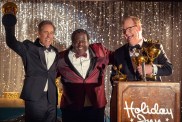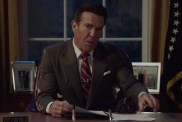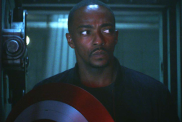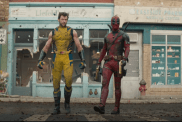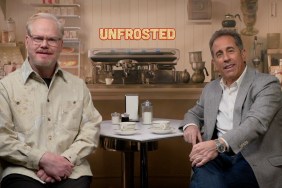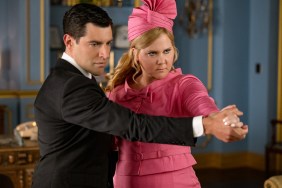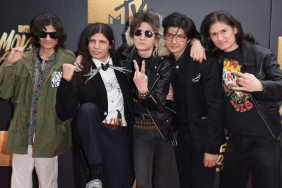Anyone who saw Pixar Animation’s WALLE last year will remember Doug Sweetland’s short “Presto” preceding it – the five-minute tale of a hungry rabbit named Alec and his cruel magician master who won’t give him his carrot until he performs a complex version of the rabbit-in-a-hat trick, a hilarious test of wills as Alec starts to put Presto the Magician through all sorts of tortures until he gets fed.
Last month, Sweetland’s debut short was nominated for an Oscar in the Animated Shorts category, and on Friday, it will open in select cities as part of Magnolia/Shorts International’s special presentation of The 2008 Academy Award-Nominated Short Films, so ComingSoon.net got on the phone with Sweetland to talk about how “Presto” came to be.
It’s kind of amazing to think that one can spend 20 minutes talking about a 5-minute short, but “Presto” went through a really interesting process, and Sweetland is certainly an animation filmmaker who we’ll be seeing more of in the future, especially if “Presto” wins the Oscar. (As Sweetland will attest himself, it does have a lot of equally great competition in its category.)
ComingSoon.net: I’ve talked to a lot of the guys at Pixar who do features and a lot of the directors at other studios but never talked to anyone who directed a short. What’s the process for getting a short rolling over at Pixar?
Doug Sweetland: Well, it’s not actually totally clear. I think you just get an idea and start pitching it around. I was talking with Mary Coleman in development really early on about wanting to do a short, and I think we got this short started just by pitching it around just expressing really that was what I was interested in doing.
CS: Now was it just the idea of a hungry rabbit and a magician with a magic hat? What was the general original pitch idea?
Sweetland: Yeah, that changed a lot actually. ‘Cause I wanted to really do the project, I came up with a pitch, along with my wife, where thought I was gearing it towards, you know, Pixar’s tastes by having it be kind of like more buddy-oriented and having two sympathetic characters. So the magician actually was a really nice guy in the original pitch, as was the bunny rabbit. He was a total innocent. He was just this rabbit off the street who wanted an autograph and this magician just had his rabbit dump him, so he incorporates this rabbit off the street into the act. It was actually like two likeable guys, and that’s kind of actually the story that Pixar greenlit. I thought we were close then, I thought we had already done all of our story work and little did I know that we hadn’t even started yet. It was really in the interest of just telling a similar story that we realized an antagonistic relationship is kind of the quickest, clearest setup for both characters. It’s the easiest get, you know what I mean? So that just changed the nature of who they were like on a really fundamental level. The hungry rabbit really came out of these reviews I was having with the group of Pixar directors–we call them “The Brain Trust”–but they’re essentially our mentors for the show, our executive producers John Lasseter and Andrew Stanton as well as Bob Peterson and Pete Docter were also key in those meetings. On the one hand, you pitch an idea ’cause you have a story you want to tell, but on the other hand, I want the experience that these guys have had many, many, many times over, doing a number of feature films, let alone shorts. So you get their feedback and you try to be responsive and you try your darndest (laughs) to understand what it is you don’t even actually know yet. So a lot of it is interesting though on blind faith and just trying to be as quick and responsive as you can, and the story just takes on its own life from there.
CS: I know with a feature film it takes three or four or sometimes more years to make, but what’s the time frame for a short as far as like when you first pitched it?
Sweetland: I think all in all it’s about 14 to 16 months, close to a year and a half maybe. I pitched it really early basically at the beginning of 2007. We sort of started official production that fall, so we just did story basically through the spring and the summer and that wrapped the spring of ’08, and then we didn’t really finish post-production music and sound until, I don’t know, I guess May.
CS: Oh wow, that’s really tight actually because it played with “WALLE” in June or July, and you only finished it in May?
Sweetland: Oh, right, yeah, it had to get out; we had a month before it was released.

CS: At what point in time did you know it would be in front of “WALLE”? Did they figure that out very early on?
Sweetland: Yeah, from the very beginning we knew. It was kind of I mean, it was obvious to everybody that it was kind of put into production specifically for “WALLE” because “WALLE” didn’t have a short accompanying it at that point and it was so late in the day for that to happen. It was either we do this short in a single shot without interruption which was actually the new part. That was what was new about this short among all the shorts at Pixar. Normally, the Pixar shorts are sort of dependent on the needs of the feature, so a feature will all of a sudden go into a crunch, it will draw all of the resources of the short and the short will go on hiatus. That absolutely couldn’t happen if we were going to make the “WALLE” slot. I think it was actually a huge show of commitment on the part of the studio that we were actually given the resources and we went through a crunch concurrently with “WALLE” actually and didn’t go on a hold. In a sense actually, that was the sort of R & D for our show to see if we could make it in sort of a microcosm of a feature production.
CS: It always seems like Pixar has two or three features going on at once in various stages, and I was wondering whether you had to share animators with those productions or if you had your own team focused on finishing the short?
Sweetland: I’ve been around since “Toy Story” and to me it’s like still a new phenomenon and I think we’re still ironing out those wrinkles about how to really be like a two-crew studio. So many movies we would go into our crunch, and then when the movie was over we would have these long lulls, and now it’s like, animators on “WALLE,” they went through a crunch on it, and then they really, it seems the next day, go onto “Up” and (laughs) start the cycle immediately over again. I know that it was tight for us on “Presto,” particularly in lighting, ’cause that was the one department that really occurred at the exact same time and being at the end of the production cycle is always kind of like in dire straits. No matter what, all of the time that gets eaten up by previous departments, they have to make up for at the end. But nonetheless, we ended up getting lighters, “WALLE” was very, very generous I should say the whole time and we were able to get “Presto” done in one straight shot.
CS: Coming from the animation and storyboard side of things, is there a different skill set needed to direct a short as a feature or is it essentially the same thing where you just need to know the process and the departments and how to get them to work together?
Sweetland: I guess just ’cause of my background as an animator, I maybe understand more the nature of the production side, so even though I have no experience in any other department in production, they follow the same essential production path. You already have the blueprint of the story and you essentially are sort of building on top of that trying to improve it. The new thing for me was story and how to come up with a blueprint in the first place, and I thought that animation might be somehow analogous to that and I was completely, completely wrong. You can have a methodical approach to I think anything in production because there’s already a plan, but how you get to that plan in the first place is I found anything but methodical. It’s totally chaotic and it’s really based on trial and error. I found it was more kind of like… I had done a really, really brief stint in doing a little stand up comedy and I thought it was more like that where you put your jokes together, you go on stage, five percent of it might work and you throw everything else out, and then you start all over again. I think anybody who’s great at what they do probably goes through that period. The Marx brothers for instance, they performed on vaudeville before they made their brilliant movies, or even I think John Lasseter made a string of shorts–even though they’re all great–before making “Toy Story.” The same thing with Walt Disney, he had “Oswald,” and then “Alice,” and then he had Mickey Mouse and then he did “Snow White.” In a way, the process of pitching to “The Brain Trust” I think is taking all of that experience and condensing it so that for this one short I can basically get a condensed learning curve and hopefully get a story together in time to make this short.
CS: When you were writing and developing the story part of it, did you actually work artistically with storyboards and pictures? Did you actually have a script or was it really just developing as it goes along with different ideas?
Sweetland: Well, I guess at the beginning I did kind of write it out in words. It’s a mystery who is knocking at the door, open the door, looks down, and there’s a bunny rabbit with an autographed hat things like that; Kind of writing out basic beats and actions. Then it became really clear particularly with the device with the two hats that it’s just too cumbersome to try to describe what’s going on. That was the hardest part about pitching the idea to begin with because I was just really doing it off of beat boards and beat boards kind of don’t do that intricate sort of action justice. So quickly after it was greenlit, it became clear that we needed story artists. They came on right away and we started building a reel. We got an editor soon after that and goodness, we weren’t even working with sound. There are boards that I was drawing up, and I was still pitching verbally, but it sort of went from like beat boards to silent storyboards and then to like a working reel.

CS: But that’s the thing. There’s really no dialogue so you kind of skip the step of having the voice actors doing that stuff, right?
Sweetland: No, I mean, we did sort of like a casting call we did bring in some actors because I was just on as scratch. First of all, about not having any dialogue, that’s just like I think such a fantastic limitation and I think that’s awesome that that’s really embedded in the tradition of making shorts here at Pixar. I think there’s no better training, and plus it speaks to me as an animator who is essentially a pantomime artist. I relish that opportunity to tell a story without words spoken words anyway. As far as getting voice actors, it was a weird thing, because we’re such a small show and I was struggling so much with story we just didn’t really have time to focus on like a search from recasting our characters from myself as the scratch voice. So it’s funny, I ended up being the voice of Presto and Alec simply I think out of necessity.
CS: At some studios, I know they’ll assign each animator to do certain scenes. I don’t know if that’s how they do things at Pixar, but can you do that sort of thing when making a short? How is the work split up among the different animators?
Sweetland: On a feature, we do kind of animate by moment I think more. The scenes sometimes are maybe too big, but an animator will get anywhere from three shots to six from eights shots in a moment and focus on that. Sometimes it’ll be one character, sometimes it’ll be all the characters or just two characters. I think that’s great because then you can really just focus on it from a scene work stand point and then also you end up getting to work on a number of different characters over the course of an entire film. For instance, on “Nemo” I don’t think I ever animated the same species of character more than once actually (laughs). It was like fish, jellyfish, pelican, turtle, and so that was like, to me, a lot of fun ’cause you’re not only changing character then, but you’re changing physiology. On “Presto” it was a bit more in and of itself as kind of a scene, so maybe the chunks that we handed out to animators were a little bit smaller, but I don’t know, maybe not. There was one shot that I had wanted to animate that I kind of stole away for myself because it was in the pitch. It was just like a souvenir from the really early story days. It was like one of the little bits that actually survived all of the (laughs) horrible pitches. That was just when Presto is saved from the fall, and he goes through the hats, and lands like a ballerina. Everything else I think I just acted kind of like a pitch hitter and I tried to fill in the cracks. I did some fixing, I did some crowd animation, I did a couple scenes with Alec, I did some fixing. I think because the short was really like my responsibility more so than even a section of a feature in the animator’s responsibility, I ended doing way more for “Presto” than I had even as a supervisor on features and that was just like, incredibly fulfilling.
CS: You mentioned the Marx Brothers earlier, and I feel like this is definitely a little bit of a throwback to “Looney Tunes,” partially because of the rabbit; I’m sure you’ve heard that. Was that something you wanted to pay homage to? It definitely seems a bit meaner than most Pixar things as far as the two characters fighting which is very reminiscent of the old Bugs Bunny-Elmer Fudd battles.
Sweetland: Yeah, well that definitely became a model, just the classic cartoon Golden Era of the 1940’s. First of all, that was an example of something that I’d heard about, but I didn’t quite believe, which is kind of what I was suggesting before how you can think you’re custom-tailoring your pitch to your audience in this case, you know, Pixar producers and directors. For me, thinking that we would do this kind of short, funny relationship, that they would dig it. I’d heard actually that the thing that you think they’ll like the least is generally what they’ll like the most, and it was something I’d kind of said off-hand really during one of these pitches. I’d said, “Yeah, it could be like a classic cartoon,” and that was something that John Lasseter kind of latched onto and wouldn’t let go of. This was a really antagonistic relationship. It completely surprised me, the abandon with which they went for that, and that’s just awesome because I don’t think they have any agenda with the choices they make kind of on like the global level. They just really do want to see what they are interested in, you know? It just seemed like it was the right fit. Like I say, it was also about getting Presto on stage like in 30 seconds or less and so we just needed like the quickest, most instant setup. The cartoons have the quickest… you just understand the relationship quickly and then off they go.

CS: Hey, it works, you know? And it’s hilarious.
Sweetland: Yeah, thank you. Well, I should also say too that like as soon as John really latched onto that idea, I became afraid actually of, “My goodness, are we ever even really going to be able to do justice? This short needs to stand on its own. It can’t be an imitation. It can’t even really just be an homage. It has to have its own life.” That in a way, as inspiring as it was, it was also kind of frightening, so we just took extra pains to make sure that our characters were real and that the story was self-contained. There are also a number of things that make it still at heart truly a Pixar short the fact that they reconcile in the end. It doesn’t have any of the conveniences of a lot of 2-D animated shorts that you can kind of do a gag, cross-dissolve to another gag, cross-dissolve to another gag, etc. You know, it takes place in real time. It feels a bit more like it’s maybe a sequence from a feature rather than a collection of gags.
CS: I wanted to ask, have you seen any of your competition for the Oscar animated shorts yet, especially anyting that’s impressed you?
Sweetland: I’ve seen actually all but one which I can’t find, but I think its “This Way Up.” Have you seen it ’cause I can’t find it on the internet. I definitely want to see it. I guess I’ve only found it was on sale on iTunes in Britain now, not in the American market. I’m sure I’ll see as we do these kind of nomination screenings. Actually, I had met the guys who did “Oktapodi” back in Annecy (an animated film festival market), so we spent like a night of celebrating way back in June. Those guys are pals.
CS: Just celebrating the fact that you finished your shorts?
Sweetland: Oh yeah, absolutely, and that we were both in Annecy. I mean, that was a very heady time for me anyway. Annecy’s amazing, I’d never been before, but yeah, I checked it out and I’m just completely amazed. Having traveled with “Presto” and having seen a lot of shorts this year and a lot more than I normally do, it’s amazing to even be in the company of those in the festivals. You realize then how many go into the nominee process, and in particular, for being a studio short, that makes it among these great, really artistic, independent shorts and the great student work. It’s really awesome to be included in that community.
CS: Absolutely. Do you have any idea what you’re going to do next? Do you feel at this point you’re ready to do a full feature? After going from the animation department to directing a short, what happens next? Do you go back into the animation pool or do you try to start something new?
Sweetland: Well, I don’t know. It’s safe to say that luckily I’m still here at Pixar, I still have a job which I’m happy about. I was actually worried about that during the story process. I actually am just starting to now focus on what’s next. I would love the opportunity to work on a conceptual level with a story again, but I also animated on “Presto” and that was like a completely new animating experience for me, so I definitely don’t want to give that up necessarily either, but I really don’t know at this point.
“Presto” is playing as part of the animation program in Magnolia and Shorts International’s The 2008 Academy Award-Nominated Short Films, along with the five other live-action shorts and four other animated shorts, playing in select theatres starting today, Friday, February 6. You can find out where it’s playing here.

